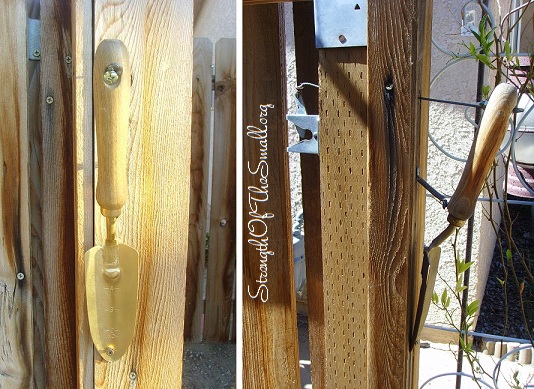This is one of the first projects I worked on when we first bought our House in 2007. The original gate latch fell apart and we needed to keep the gate closed at all times. It is a fun and simple projects to do. It is so easy to maneuver and latches every time you push the gate closed behind you.
Materials Needed:
- Shovel, Pitchfork, Rake, Hoe, Harrow, Fishtail Hand Weeder (or any garden tool with a wooden handle)
- Screws
- Gate Latch
- Cable Rope
- Drill and a Drill Bit (to make the holes)
- A Spring (for pulling the Shovel)
Step by step:
- First step is to use the drill and drill bit to make a hole that will allow the cable rope to go from the latch to the opposite side of the fence. Try and make the hole slightly bigger than the cable wire diameter since it will need to move freely back and forth.
- Attach the cable rope to the gate latch and run it thru the hole you have drilled. Now choose the area on the object you want to use as the handle and line it up to the cable rope. Make sure that when the object gets pulled, the cable rope will move the latch open and closed freely.
- Use the screws to screw the object to the fence. Once it is fastened to the fence, use the spring to calculate how far the object will be off the fence. As you can see from the picture I decided to place the spring lower on the gardening shovel to have it sit at an angle.
- Screw the spring to the fence and then to the object. Once done you are ready to attach the cable rope to the object and test it. After pulling on the handle it should pull the latch open. When you release the handle the spring will pull the handle back in place and the latch will go down far enough where pulling the gate close will latch it closed.
Wrenches can be used as door handle as well as other tools. All you have to do is use your imagination.

Make sure you apply clear coat on the wood handle to give a clear and shinning finish and most importantly, to protect the wood from scrapes, the weather and also to help it last as long as possible.













